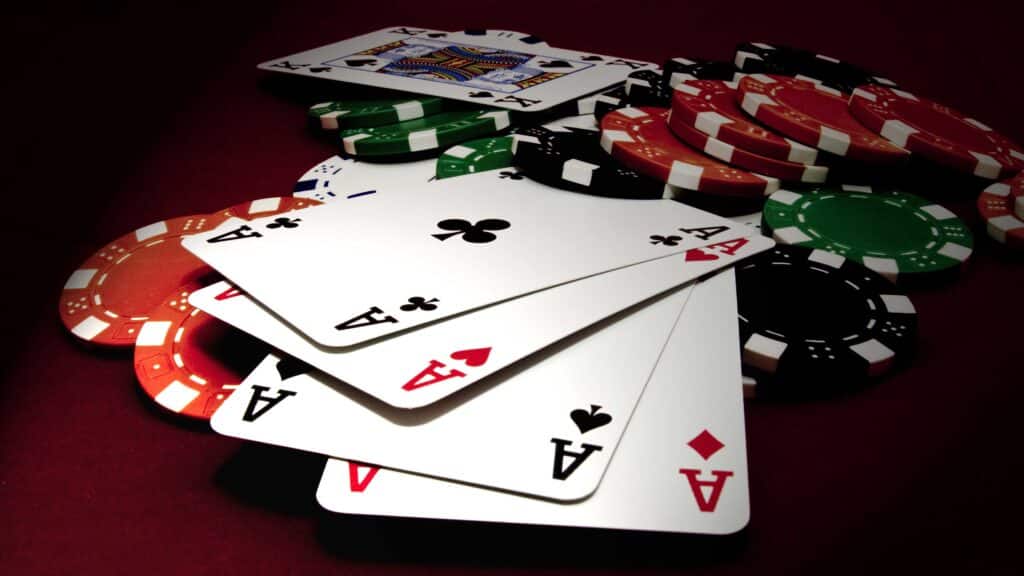Transitioning from the fast-paced digital realm of online poker to the tangible, social environment of live poker is a significant shift for many players. While both formats share the fundamental rules of poker, the psychological, strategic, and practical differences are profound. This in-depth article explores the key distinctions between online and live poker, providing a comprehensive guide for online players looking to successfully navigate the transition to the live felt.
Key Differences: Online vs. Live Poker
The move from online to live poker is not merely a change of venue; it's a transition into a different game altogether. Understanding these core differences is crucial for online players to adapt and thrive in the live poker environment.
- Pace of Play: Online poker is characterized by its rapid pace. Multiple tables, automated dealing, and instant decision-making tools allow for hundreds of hands per hour. Live poker, in contrast, is significantly slower. Dealing is manual, decisions take longer, and there's only one table at a time. This slower pace demands patience and adjustments to playing style.
- Information Availability: Online poker often provides HUDs (Heads-Up Displays) and tracking software that offer real-time statistics on opponents. Live poker strips away these digital aids. Information is gleaned from observation – physical tells, betting patterns, conversation, and table dynamics. This shift requires developing keen observational skills.
- Opponent Pool and Skill Level: Online poker offers a vast player pool, ranging from novices to seasoned professionals, across various stakes. Live poker player pools are typically smaller and can vary greatly in skill level depending on location and venue. Live games may include more recreational players, but also local regulars who are highly experienced in the specific live environment.
- Multi-tabling vs. Single Table Focus: Online players often multi-table, playing on several tables simultaneously to increase volume and win rate. Live poker is exclusively a single-table game. This necessitates a shift in focus from volume to maximizing value at a single table, requiring deeper engagement with each hand and opponent.
- Betting Structure and Dynamics: While betting rules are consistent, the dynamics differ. Online, betting is often standardized and rapid. Live poker involves physical chips, verbal declarations, and nuanced betting patterns that can reveal information. Players must become comfortable with chip handling and live betting etiquette.
- Rake and Expenses: Online poker generally has lower rake (the commission taken by the poker site) than live poker rooms. Live poker also involves additional expenses like travel, tips for dealers and staff, and potentially food and drink. These costs impact profitability and bankroll management.
- Psychological and Social Elements: Online poker is largely impersonal. Live poker is intensely social and psychological. Reading opponents, managing table image, engaging in conversation, and controlling emotions in a face-to-face setting are paramount. The psychological game becomes as important as card play.
Acknowledging these fundamental differences is the first step in preparing for a successful transition. Online strategies and habits may not directly translate to the live arena, requiring a deliberate adaptation of approach.
Adapting Strategy for Live Poker
Online poker strategies, while fundamentally sound, need adjustments for the nuances of the live game. A direct copy-paste approach is unlikely to be effective. Live poker demands a more holistic and opponent-centric strategy.
- Exploitative Play Over GTO (Game Theory Optimal): Online poker often leans towards GTO strategies, aiming for unexploitable play against unknown opponents. Live poker is ripe for exploitative play, targeting specific opponent weaknesses and tendencies. Identifying and exploiting leaks in live opponents becomes more profitable than strict GTO adherence.
- Reading Physical Tells: Live poker introduces the element of physical tells – subtle, often unconscious, physical cues that can reveal information about a player's hand strength or intentions. Learning to observe and interpret tells, such as eye movement, body posture, breathing patterns, and hand gestures, adds a new dimension to hand reading.
- Bet Sizing and Value Extraction: Online bet sizing is often standardized and mathematically driven. Live poker allows for more nuanced bet sizing to extract maximum value or induce bluffs. Adjusting bet sizes based on opponent type, perceived hand strength, and table dynamics becomes crucial. Over-betting can be more effective live, and smaller value bets can be missed opportunities if opponents are calling stations.
- Table Image and Reputation: In live poker, your table image – how opponents perceive you – is a significant factor. Building a specific image, whether tight, loose, aggressive, or passive, can be strategically advantageous. Managing your reputation and exploiting opponent perceptions becomes part of your overall strategy.
- Bluffing Frequency and Timing: Bluffing frequencies need adjustment. Live players, especially at lower stakes, tend to be less inclined to fold. Bluffing too frequently, as might be common online, can be costly. Bluffing needs to be more selective, well-timed, and targeted at specific opponents who are capable of folding.
- Value Betting Emphasis: Given the tendency of live players to call more often, maximizing value from strong hands becomes paramount. Thin value betting, extracting extra chips with marginal but leading hands, is a key skill in live poker.
- Utilizing Position Aggressively: Positional advantage is amplified in live poker. Playing aggressively in position, especially against weaker players, allows for greater control of the hand and increased opportunities to extract value or bluff effectively.
Adapting strategy for live poker is an ongoing learning process. Observation, experimentation, and a willingness to adjust to the specific table dynamics are essential for success.
Psychological Adjustments for Live Poker
The psychological demands of live poker are significantly different from online play. Online players accustomed to the digital detachment need to develop a new set of psychological skills to thrive in the live environment.
- Patience and Emotional Control: The slower pace of live poker can be frustrating for online players used to rapid action. Cultivating patience is essential. Emotional control is even more critical. Live poker can be emotionally taxing, with swings, bad beats, and social pressures amplified in a live setting. Maintaining composure and avoiding tilt are paramount.
- Reading People and Social Dynamics: Live poker is a social game. Developing skills in reading people – both for tells and understanding personalities – is vital. Table talk, social interaction, and understanding table dynamics become strategic tools. Online players need to become comfortable with face-to-face interaction and leveraging social cues.
- Managing Table Image and Ego: In live poker, your ego can be your worst enemy. Players need to manage their table image strategically, which may involve making plays that seem suboptimal in isolation but serve a larger purpose. Avoiding ego-driven plays and focusing on long-term profitability is crucial.
- Dealing with Distractions and Live Environment: Live poker rooms are often noisy, distracting environments. Players need to develop focus and concentration to filter out distractions and maintain focus on the game. This is a significant shift from the controlled environment of online play.
- Handling Pressure and Nerves: Playing live poker, especially for the first time or at higher stakes, can be nerve-wracking. Managing pressure, controlling anxiety, and maintaining confidence are important psychological skills to develop. Deep breathing, visualization, and positive self-talk can be helpful techniques.
- Bankroll Management in a Live Setting: Live poker bankroll management requires adjustments. Higher expenses (travel, tips) and potentially higher variance (due to exploitative play and opponent unpredictability) necessitate a more conservative bankroll approach. Players need to factor in these live-specific costs and variance when setting bankroll requirements.
- Ethical Considerations and Etiquette: Live poker has a strong code of etiquette and ethical conduct. Players need to be aware of and adhere to these norms, which include acting in turn, protecting their hands, avoiding slow-rolling, and maintaining respectful behavior at the table. Understanding and respecting live poker etiquette is crucial for a positive and accepted experience.
The psychological transition to live poker is as important as the strategic adaptation. Developing emotional resilience, social awareness, and disciplined bankroll management are key to long-term success and enjoyment in the live poker arena.
Practical Tips for Transitioning to Live Poker
Making the transition from online to live poker requires a practical approach, starting with preparation and gradual acclimatization.
- Start Small and Low Stakes: Begin with the lowest stakes live games available to get comfortable with the live environment without significant financial risk. Focus on observation, learning, and adapting to the pace and social dynamics.
- Observe and Learn from Live Players: Spend time observing live games before playing. Watch experienced players, note their betting patterns, table talk, and how they interact with opponents. Learning by observation is invaluable.
- Practice Chip Handling and Betting: Practice handling chips and making bets smoothly and confidently. Familiarize yourself with verbal declarations and betting etiquette to avoid awkward situations.
- Develop Live Reading Skills: Consciously practice observing players for physical tells and betting patterns. Start with broad observations and gradually refine your ability to detect subtle cues.
- Engage in Table Talk (Strategically): Start experimenting with table talk, initially focusing on friendly conversation and gradually incorporating strategic table talk to gain information or influence opponents.
- Manage Your Bankroll Conservatively: Allocate a separate bankroll for live poker, and manage it more conservatively than your online bankroll. Factor in live expenses and potential higher variance.
- Review and Analyze Live Sessions: After each live session, review your play. Analyze hands, decisions, and your reads on opponents. Identify areas for improvement and adjust your strategy accordingly.
- Seek Mentorship or Coaching (Optional): Consider seeking guidance from experienced live poker players or coaches who can provide personalized advice and accelerate your learning curve.
- Be Patient and Persistent: The transition to live poker takes time and practice. Be patient with yourself, embrace the learning process, and persist through initial challenges and adjustments.
- Enjoy the Live Experience: Live poker offers a unique social and psychological experience that online poker cannot replicate. Embrace the social interaction, the challenge of reading people, and the overall atmosphere of the live game.
Common Mistakes to Avoid in Live Poker Transition
Online players transitioning to live poker often make predictable mistakes. Being aware of these pitfalls can help players avoid them and accelerate their adaptation.
- Playing Too Many Hands (Online Habit): Online players used to multi-tabling may be tempted to play too many hands in live poker out of boredom or habit. Live poker rewards tighter, more selective play.
- Over-Bluffing (Online Aggression): Online aggression and bluffing frequencies often need to be toned down in live games, especially at lower stakes where players call more readily.
- Ignoring Physical Tells and Social Cues: Failing to pay attention to physical tells and social dynamics is a major mistake. Live poker is rich with non-verbal information that online players often overlook initially.
- Underestimating Live Opponents: Assuming live opponents are weaker than online players can be a costly error. Live games contain a mix of skill levels, and many experienced live regulars are highly adept at exploiting online transplants.
- Poor Bankroll Management (Live Expenses Ignored): Neglecting to adjust bankroll management for live poker expenses and potential variance can lead to premature bankroll depletion.
- Lack of Patience and Tilt Control (Live Swings): The slower pace and social pressures of live poker can test patience and exacerbate tilt. Failing to manage emotions and tilting in live games can be particularly damaging.
- Being Unfamiliar with Live Etiquette: Violating live poker etiquette can be off-putting to other players and can even lead to warnings or ejection from the game. Being respectful of etiquette is essential for a positive live poker experience.
- Trying to Multi-table Mentally: Attempting to maintain the same level of hand volume or strategic complexity as multi-tabling online is counterproductive in live poker. Focus on maximizing value at the single table.
- Over-Reliance on Online Strategies (Unadapted): Directly applying online strategies without adjustment for live dynamics is unlikely to be optimal. Live poker requires a tailored approach.
- Ignoring Table Dynamics and Player Types: Failing to adapt to the specific table dynamics and player types at a live table is a missed opportunity. Live poker is highly situational, and strategy should be fluid and responsive to the game environment.
By being mindful of these common pitfalls and proactively addressing them, online players can smooth their transition to live poker and increase their chances of success.
Conclusion: Embracing the Live Poker Journey
Transitioning from online to live poker is a challenging but rewarding journey. It requires strategic adaptation, psychological adjustments, and practical preparation. While online poker offers speed and data-driven play, live poker provides a richer, more human experience, demanding social intelligence, emotional control, and keen observation. For online players willing to embrace these differences and invest in developing live-specific skills, the transition to live poker opens up new avenues for enjoyment, challenge, and potentially, profitability. The future of poker likely involves a blend of both online and live formats, and mastering both realms offers the most comprehensive and fulfilling poker experience. As players navigate this evolving landscape, understanding the unique psychology and dynamics of each format will be key to sustained success and enjoyment in the game.
External Resources:



